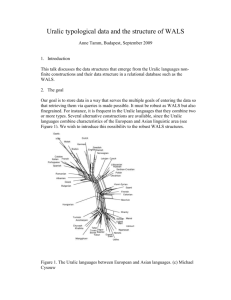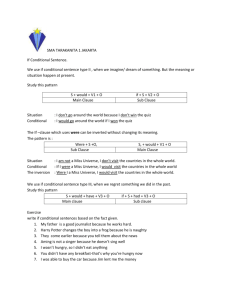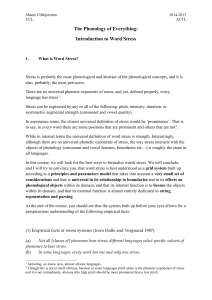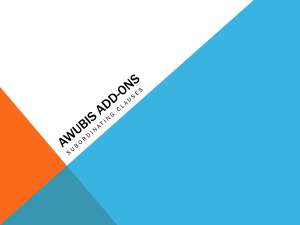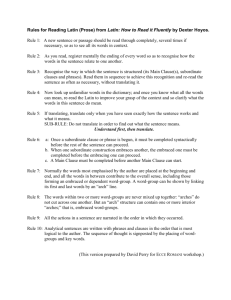Conditional constructions in the Uralic languages: a
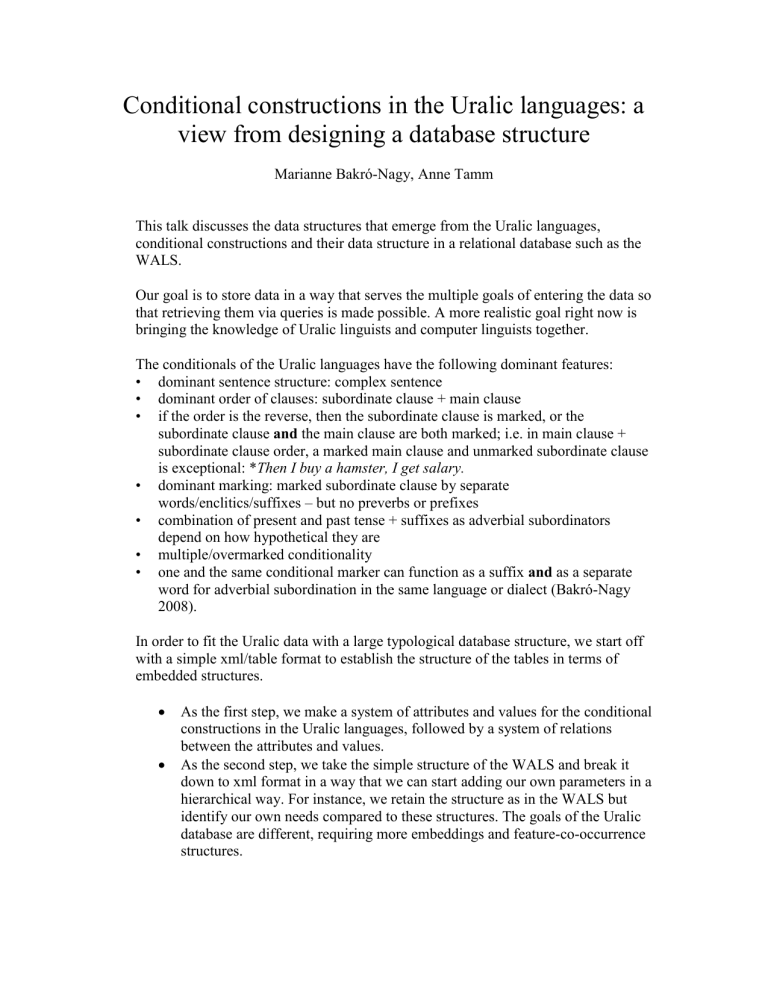
Conditional constructions in the Uralic languages: a view from designing a database structure
Marianne Bakró-Nagy, Anne Tamm
This talk discusses the data structures that emerge from the Uralic languages, conditional constructions and their data structure in a relational database such as the
WALS.
Our goal is to store data in a way that serves the multiple goals of entering the data so that retrieving them via queries is made possible. A more realistic goal right now is bringing the knowledge of Uralic linguists and computer linguists together.
The conditionals of the Uralic languages have the following dominant features:
• dominant sentence structure: complex sentence
• dominant order of clauses: subordinate clause + main clause
• if the order is the reverse, then the subordinate clause is marked, or the subordinate clause and the main clause are both marked; i.e. in main clause + subordinate clause order, a marked main clause and unmarked subordinate clause is exceptional: * Then I buy a hamster, I get salary.
• dominant marking: marked subordinate clause by separate words/enclitics/suffixes – but no preverbs or prefixes
• combination of present and past tense + suffixes as adverbial subordinators depend on how hypothetical they are
• multiple/overmarked conditionality
• one and the same conditional marker can function as a suffix and as a separate word for adverbial subordination in the same language or dialect (Bakró-Nagy
2008).
In order to fit the Uralic data with a large typological database structure, we start off with a simple xml/table format to establish the structure of the tables in terms of embedded structures.
As the first step, we make a system of attributes and values for the conditional constructions in the Uralic languages, followed by a system of relations between the attributes and values.
As the second step, we take the simple structure of the WALS and break it down to xml format in a way that we can start adding our own parameters in a hierarchical way. For instance, we retain the structure as in the WALS but identify our own needs compared to these structures. The goals of the Uralic database are different, requiring more embeddings and feature-co-occurrence structures.
As the third step, we enrich the simple structure with the most robust parameter system that we can. Also, new descriptions of the values can be added to a values table.
As the fourth step, we fine-tune the parameter-value system by adding extra structures (i.e. extra tables and indices), combining the WALS-like data structure with the structures that serve the goal of storing the Uralic data as described above. o At this stage, we add information such as the võro language code or information about major dialects, e.g., vor. o In addition, we add information such as an index that allows us to introduce multiple values for one feature. WALS records probably the most frequent one for Uralic languages, but we wish to have a more fine-grained structure. This is provided at this stage of database development. o Additional data for languages are added at this stage, as if adding them to the WALS table on languages. o Additional data for features can be added by extra numeric feature identifiers in the WALS-like table features. However, each of these additions, if we wish to keep them separate but still compatible with the data in WALS to perform larger queries, should be linked to an extra index encoding the source attribute with the Uralic Database value.
In sum, we present the specific features of the Uralic conditionals in the possible Uralic
Typology Database structure. We identify the parameters and values that are generally relevant, and those that pertain to the Uralic. We present our “wish list”, structures and data that can be fitted into a WALS-like structure, and a roadmap of how to meet the demands of a large database and the Uralic conditional structures.
References
Bakró-Nagy, Marianne 2008. Conditional constructions in Uralic. MS, September 2008,
Vienna. URL http://www.univie.ac.at/urtypol/bakro.pdf
WALS = Haspelmath, Martin & Dryer, Matthew S. & Gil, David & Comrie, Bernard
(eds.) The World Atlas of Language Structures Online. Munich: Max Planck Digital
Library, chapter 39. Available online at http://wals.info/
Tamm, Anne 2009. Uralic typological database structure and the structure of WALS. MS,
September 2009, RIL HAS, Budapest,
URL http://uralictypology.pbworks.com/f/UralicTypologyDatabases.doc
